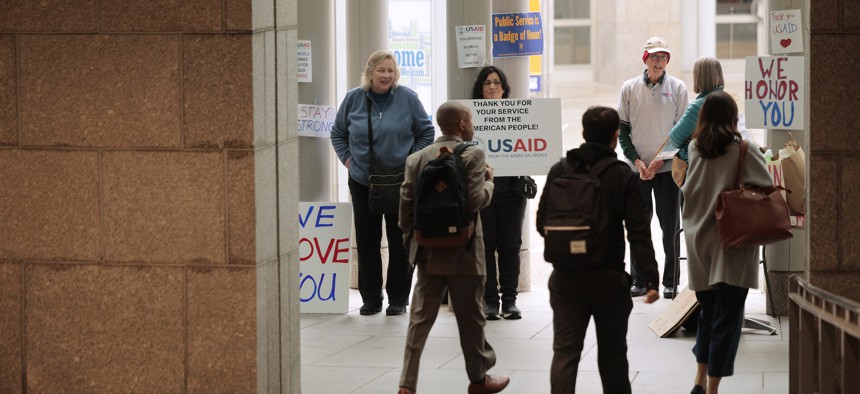
Supporters hold signs outside of the U.S. Agency for International Development as terminated employees come to collect their personal belongings on Feb. 27, 2025, in Washington, D.C. The Trump administration has aimed to shrink the size of the federal workforce, including nearly all of the staffers at USAID. Chip Somodevilla / Getty Images
At least 148,000 federal employees have left government under Trump, good government group reports
The Partnership for Public Service acknowledged that it’s difficult to track the number of civil servants who have departed because the Trump administration has not publicized much of the information.
More than 148,000 civil servants have involuntarily or voluntarily separated from the government workforce as of July 21, according to the Partnership for Public Service. The finding is part of a project that the nonpartisan good government group recently launched to serve as a “one stop shop” of information about President Donald Trump’s efforts to overhaul federal agencies.
“We're seeing a pitch black battlefield of lots of carnage that is growing on a daily basis from the changes that the Trump administration is making to our government. And we have little pen lights of information that are vital to the public's understanding about what is happening,” said Partnership president and CEO Max Stier in a press call Thursday. “We think we need a flood light, and we have created the tracker to help aggregate and add to the understanding in a comprehensive way of some of the changes and harms that are taking place.”
The Partnership measured employees departing from government by relying on official agency documents and media reports and will update the data monthly. Its analysis doesn’t include reinstatements, job removals reversed by courts or employees who are just on administrative leave. (The organization does, however, count workers who took the deferred resignation offer, which generally puts participants on paid leave through Sept. 30.)
Stier said that it’s been difficult to collect this information because the Trump administration has not publicized much of it. He did, however, express appreciation to the Office of Personnel Management for updating FedScope, a platform with federal workforce data, through March.
“We are excited to see that they have responded in this way to provide data,” he said. “I will say that up until now, they haven't been doing that in any way, shape or form.”
OPM updated FedScope on July 1 in conjunction with a plan to modernize the portal; although, the effort was started under former President Joe Biden’s administration.
Bloomberg Law reported in April that nearly all of the team who compiled data for the platform had been laid off or took a separation incentive.
The number of federal employees who have left under the second Trump administration has not been consistently captured. For example, The Washington Post on Thursday reported, based on two anonymous OPM officials, that more than 154,000 civil servants are taking part in the deferred resignation program alone.
There are roughly 2.3 million civilian federal employees.
According to the Partnership’s data, the three departments most affected by the workforce reductions are Treasury (31,201), Agriculture (21,600) and Defense (20,364).
Stier is particularly concerned about job cuts at the IRS, which is under Treasury. The tax agency has lost 8,600 customer service employees, mostly through separation incentives, but the president in his fiscal 2026 budget has asked Congress for more funding to hire 11,000 such workers to avoid a reduction in the assistance they provide.
“This is one of the things that we're seeing in repeated instances where they have, in a non-strategic way, let go of lots of people that provide vital functions, and then they look up and realize, ‘Wow, we're not going to be able to do something that is quite important, and we're going to have to rehire people,’” Stier said. “It's a phenomenal waste in multiple different ways.”
Once the administration begins hiring government workers more broadly, Stier is worried that initiatives like Schedule G, a new classification to increase the number of political appointees, and asking applicants to write about their favorite Trump policy will further weaken the civil service.
“They're clearing the cupboard and they're putting in place a system to restock the shelves with a class of people that are focused on their loyalty as opposed to their competence and character,” he said. “That would be an enormous mistake and have large consequences for everybody.”
Share your news tips with us:
Sean Michael Newhouse: snewhouse@govexec.com, Signal: seanthenewsboy.45
NEXT STORY: Senate Dems join calls for EPA to reinstate dissenting workers







